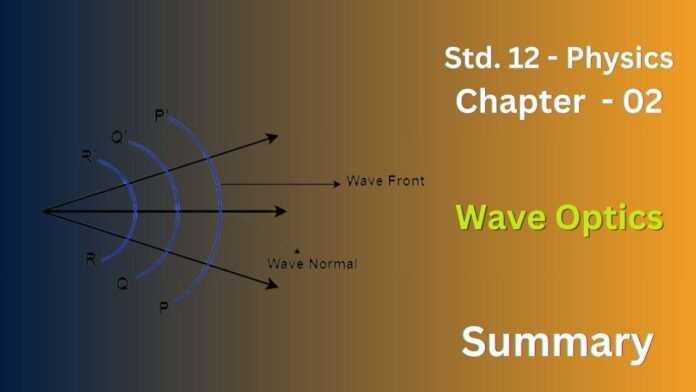2. Wave Optics
The chapter “Wave Optics” from the 12th standard physics part 2 NCERT textbook covers the wave nature of light and related phenomena. It begins by introducing Huygens’ principle, which states that every point on a wavefront can be considered a source of secondary spherical wavelets. The new wavefront is then
The envelope of these wavelets. This principle is used to explain the reflection and refraction of light at plane surfaces. The chapter then discusses the interference of light waves, including Young’s double-slit experiment, which demonstrates the wave nature of light and the principle of superposition. The concept of diffraction, which is the bending of light waves around obstacles, is also explained. Finally, the chapter discusses the polarization of light, which is the phenomenon where light waves vibrate in a specific direction
Exercise
1 Monochromatic light of wavelength 589 nm is incident from air on a water surface. What are the wavelength, frequency and speed of (a) reflected, and (b) refracted light? Refractive index of water is 1.33.
Ans :
Given Information
- Wavelength of incident light (λ_air) = 589 nm = 589 x 10^-9 m
- Refractive index of water (n_water) = 1.33
- Speed of light in air (c)
- = 3 x 10^8 m/s
Calculations
(a) Reflected Light
- Wavelength (λ_reflected) = λ_air = 589 nm
- Frequency (f_reflected) = f_air (We’ll calculate this below)
- Speed (v_reflected) = c = 3 x 10^8 m/s
(b) Refracted Light
- Frequency:
- First, find the frequency of the incident light (which is the same as the reflected and refracted light’s frequency):
- f_air = c / λ_air = (3 x 10^8 m/s) / (589 x 10^-9 m) ≈ 5.09 x 10^14 Hz
- f_refracted = f_air ≈ 5.09 x 10^14 Hz
- First, find the frequency of the incident light (which is the same as the reflected and refracted light’s frequency):
- Speed:
- The speed of light in water (v_water) is related to the speed of light in air (c) and the refractive index of water (n_water):
- v_water = c / n_water = (3 x 10^8 m/s) / 1.33 ≈ 2.26 x 10^8 m/s
- The speed of light in water (v_water) is related to the speed of light in air (c) and the refractive index of water (n_water):
- Wavelength:
- The wavelength of the refracted light (λ_water) can be found using the following relationship:
- λ_water = v_water / f_refracted = (2.26 x 10^8 m/s) / (5.09 x 10^14 Hz) ≈ 4.44 x 10^-7 m = 444 nm
- The wavelength of the refracted light (λ_water) can be found using the following relationship:
2. What is the shape of the wavefront in each of the following cases:
(a) Light diverging from a point source.
(b) Light emerging out of a convex lens when a point source is placed at its focus.
(c) The portion of the wavefront of light from a distant star intercepted by the Earth.
Ans :
(a) The wavefront is spherical. Imagine a point source emitting light in all directions. All the points equidistant from the source at any given time form a sphere.
(b) The wavefront is planar (or plane). When a point source is placed at the focus of a convex lens, the lens converges the diverging light rays into parallel rays. These parallel rays define a plane wavefront.
(c) The wavefront is essentially planar (or plane). Because the star is so incredibly far away, the spherical wavefront it emits has an extremely large radius by the time it reaches Earth. A small portion of this enormous sphere intercepted by Earth appears almost flat, like a plane. Think of it like a tiny section of a very large circle—it looks almost like a straight line
3 (a) The refractive index of glass is 1.5. What is the speed of light in glass? (Speed of light in vacuum is 3.0 x 10 m s131)
(b) Is the speed of light in glass independent of the colour of light? not, which of the two colours red and violet travels slower in glass prism?
(a) Speed of light in glass:
- Refractive index (n) = Speed of light in vacuum (c) / Speed of light in medium (v)
- Given:
- n = 1.5
- c = 3.0 x 10^8 m/s
- Calculation:
- v = c / n = (3.0 x 10^8 m/s) / 1.5 = 2.0 x 10^8 m/s
- Answer: The speed of light in glass is 2.0 x 10^8 m/s.
(b) Speed of light and color:
- No, the speed of light in glass is not independent of the color of light. This phenomenon is known as dispersion.
4. In a Young’s double-slit experiment, the slits are separated by 0.28 mm and the screen is placed 1.4 m away. The distance between the central bright fringe and the fourth bright fringe is measured to be 1.2 cm. Determine the wavelength of light used in the experiment.
Ans :
nλ = d sin θ
For small angles (which is usually the case), we can approximate sin θ as y/D, where:
- y is the distance between the central bright fringe and the nth bright fringe on the screen
- D is the distance between the slits and the screen
Therefore, the formula becomes:
nλ = (d * y) / D
Given Information
- Slit separation (d) = 0.28 mm = 0.28 x 10^-3 m
- Distance to screen (D) = 1.4 m
- Distance to 4th bright fringe (y) = 1.2 cm = 1.2 x 10^-2 m
- Order of fringe (n) = 4
Calculation
λ = (d * y) / (n * D)
Now, plug in the values:
λ = (0.28 x 10^-3 m * 1.2 x 10^-2 m) / (4 * 1.4 m)
λ = (3.36 x 10^-6 m^2) / 5.6 m
λ = 6 x 10^-7 m
λ = 600 x 10^-9 m
λ = 600 nm
5. In Young’s double-slit experiment using monochromatic light of wavelength 2, the intensity of light at a point on the screen where path difference is λ. is K units. What is the intensity of light at a point where path difference is 2/3?
Ans :
φ = (2π/λ) * Δx
The intensity (I) is given by:
I = I₀ * cos²(φ/2)
where I₀ is the maximum intensity.
Given Information
- Wavelength = λ
- Intensity at path difference λ is K.
Calculations
- Path difference λ:
- Phase difference (φ₁) = (2π/λ) * λ = 2π
- Intensity (I₁) = I₀ * cos²(2π/2) = I₀ * cos²(π) = I₀ * (-1)² = I₀
- Since I₁ = K, we have K = I₀.
- Path difference λ/3:
- Phase difference (φ₂) = (2π/λ) * (λ/3) = (2π/3)
- Intensity (I₂) = I₀ * cos²((2π/3)/2) = I₀ * cos²(π/3) = I₀ * (1/2)² = I₀/4
- Since I₀ = K, we have I₂ = K/4
6. A beam of light consisting of two wavelengths, 650 nm and 520 nm, is used to obtain interference fringes in a Young’s double-slit experiment.
(a) Find the distance of the third bright fringe on the screen from the central maximum for wavelength 650 nm.
(b) What is the least distance from the central maximum where the bright fringes due to both the wavelengths coincide?
Ans :
nλ = (d * y) / D
where:
- n is the order of the bright fringe
- λ is the wavelength
- d is the distance between the slits
- y is the distance from the central maximum
- D is the distance to the screen
Given Information (Let’s assume d and D are given as they are essential to solve the problem. If they are not, the answer will be in terms of d and D)
- λ₁ = 650 nm = 650 x 10^-9 m
- λ₂ = 520 nm = 520 x 10^-9 m
- Let the distance between slits be ‘d’ meters
- Let the distance to the screen be ‘D’ meters
(a) Third bright fringe for λ₁ = 650 nm:
- n = 3
- We want to find y₁
Using the formula:
3 * (650 x 10^-9 m) = (d * y₁) / D
y₁ = (3 * 650 x 10^-9 m * D) / d
y₁ = (1950 x 10^-9 * D)/d meters
(b) Coinciding bright fringes:
Bright fringes will coincide when the condition n₁λ₁ = n₂λ₂ is met, where n₁ and n₂ are integers representing the order of the fringes for each wavelength. We are looking for the least distance, which means we want the smallest integer values for n₁ and n₂ that satisfy this condition.
n₁ * 650 nm = n₂ * 520 nm
n₁/n₂ = 520/650 = 4/5
So, the smallest integer values are n₁ = 4 and n₂ = 5.
Now, we can find the distance y where they coincide. We can use either wavelength:
Using λ₁ and n₁ = 4:
4 * 650 x 10^-9 m = (d * y) / D
y = (4 * 650 x 10^-9 m * D) / d
y = (2600 * 10^-9 *D)/d meters
Or using λ₂ and n₂ = 5:
5 * 520 x 10^-9 m = (d * y) / D
y = (5 * 520 x 10^-9 m * D) / d
y = (2600 * 10^-9 *D)/d meters
Both equations give the same result for y, as expected.


